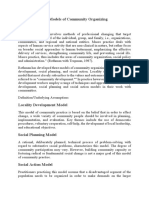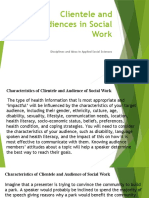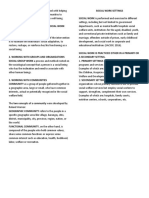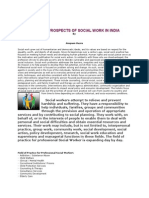Social Action is an approach for the 21st Century and the possibilities for developing Social
Action is endless. It is a way of working across the human services, a method of community
development that is both progressive and effective. It provides a way forward for
communities and professionals looking to implement the goals of personalisation,
co-production, localism, partnership, social inclusion, community cohesion, participation,
involvement, self-advocacy, anti-oppressive practice and anti-discriminatory working.
Social Action has been used in many different settings in countries around the globe. It is
truly an international practice that can be tried and adapted for many different settings.
While the context may change there are some things that remain constant - the values,
principles and methods. These however are not static or set in stone. They evolve, change
and are built on, every time a Social Action group meets. However the cornerstones of the
approach are non-negotiable.
Social Action redefines the relationship between professionals and communities and service
users. It creates a negotiated and democratic framework for true partnership working. It
is inclusive rather than exclusive and engages the most ‘hard to reach’ groups because it
starts from their understanding of what needs to change and engages them in this process.
This is in contrast to many approaches that define communities and people in negative
terms, seeing them as the problem to be tackled, changed, modified.
Compensation :
This approach sees people and or communities as being deprived. This can be economic,
environmental, or social deprivation. The aim is to compensate for this by providing
experiences that are normally denied in everyday life. This often takes the form of activ-
ity or recreational programmes, sometimes in the community or taking people away from
a ‘bad environment’. However, taking people away from their communities and environ-
ment does nothing to address the underlying causes of challenges people face. People
can only access this approach through professionals and organizations who organize
activities for people to consume. There is little or no learning about how to organize and
make sustained, positive changes as part of everyday life, as everything is done to, for and
on behalf of people.
Reparation :
This approach sees people as having caused ‘trouble’ or offended in the community and
therefore being required to pay back a ‘debt’. The focus here is on the individual and their
offending behavior. It is applied as though crime and offending is an individual decision/act,
without any social context. This is often used as an alternative to custodial sentences. The
programmes often take the form of community service or ‘pay back’ schemes. The people taking
part in reparation schemes are largely poor males who have been caught ‘offending’. The
approach does nothing to address root causes of offending or power imbalances and
discrimination in the criminal justice system. It very much reinforces existing power relationships
and the status quo.
Modification :
This approach sees the individual or community as ‘sick’ and in need of individual or social
modification. It pathologists individuals, sections of or whole communities as ‘mad or bad’.
Depending on which of these definitions you are labeled with you will be therapised or
�taught to modify behavior.Cognitive behavioral therapy (CBT) is very popular at the moment in
the justice, social and health care systems because it can be administered in small doses –
usually six sessions and can show short term changes.By focussing solely on individual
pathology, behavior and responsibility the approach ignores the wider social and economic
environment. Because this approach addresses symptoms rather than the complexity of
people’s lives and the causes of their problems it leaves all the
wider social and power relations in place.
Paternalism :
This approach assumes that professionals know what is best for you, service users are there to
be done to, for, or on behalf of. They are not capable of doing it or organizing things for
themselves. They need to be helped. They have lots of ‘problems’ so professional expertise is
necessary to manage interventions and services on their behalf. The
service delivery model is based on participants/clients being more or less passive recipients of
services organized by others on their behalf. Services are designed and run by professionals
and people either use them or they don’t – one size fits all.The outcomes of this approach are
likely to be dependency, disempowerment, expensive ‘Take it or leave it’ services,
developmental delay, social isolation and exclusion.
Social Action approaches:
Social Action is an approach that facilitates people to articulate and understand outcomes
and goals in a way that goes beyond identifying wants and needs. It puts the responsibility
for addressing and overcoming barriers with the citizen not the professional. With its emphasis
on handing the agenda and action over to citizens, Social Action provides a methodology
for practitioners and service users to achieve this. Social Action takes as its starting point
the lived experience of people and that people are experts in their own lives. However it
doesn’t leave people here. It facilitates people to go on a journey of uncovering things for
themselves and gives them the tools to address things that they prioritise as being
important.
Social Action is more than consultation or just listening to people – it is about affecting
decision making and creating change. Not all of what is currently called participation goes
this far. Many consultation processes very effectively collect the views, concerns and
opinions of people, but do not involve them in the creation and implimentation of solutions
and implementing them. Social Action has always been about moving towards the achievement
of change. Social Action stops participation being seen as an end in itself.
Social Action as a practice was originally developed out of a commitment to social justice and
linked with this, dissatisfaction with conventional practice, education and training in the human
service professions – social work, youth work, probation, teaching and community
development. More recently the model has also been applied to health, child care, social
care, disability and social housing.
The criticisms we articulated as workers/professionals were similar, and often inspired by
the experiences and criticisms of community members and service users. As workers our
motivation for entering the human services was to be helpful, to make a positive difference.
However our work and the intervention of our agencies in the lives of community members
were often not seen as either positive or helpful.
Social Action arose out of this critique, and a desire to do things differently. With its roots
�in the UK, Social Action now works with community members of all ages, backgrounds and
abilities on four continents. It has forged alliances between ordinary people and
professionals who work in partnership to create social change together.
Social Action is different to other ways of working and methods because:
q The agenda is handed over to community members or service users
q Facilitators and group members work in partnership
q All people are viewed as having the capacity to create social change and
are given the opportunity to do so.
The essential difference of Social Action, which distinguishes it from other approaches, is
that it recasts the role of the professional worker, facilitator, leader and group/community
members. It intentionally strives to integrate into the practice the criticisms that have
come from service users and community members. The challenge is to make sense of the
role of the professional and transform it from being part of the problem to being part of the
solution. What has emerged is a way of working that redefines this role, be it practitioner,
manager, trainer or researcher. The worker does not lead but through a highly skilled
process of facilitation enables people to identify issues of concern, make choices and take
action for themselves.








































































































